McMurdo Sound
McMurdo Sound and its ice-clogged waters extends about 55 kilometres (34 mi) long and wide. The sound connects the Ross Sea to the north with the Ross Ice Shelf cavity to the south via Haskell Strait. The strait is largely covered by the McMurdo Ice Shelf. The Royal Society Range rises from sea level to 4,205 metres (13,796 ft) on the western shoreline. Ross Island, an historic jumping-off point for polar explorers, designates the eastern boundary. The active volcano Mount Erebus at 3,794 metres (12,448 ft) dominates Ross Island. Antarctica's largest scientific base, the United States' McMurdo Station, as well as the New Zealand Scott Base are on the southern shore of the island. Less than 10 percent of McMurdo Sound's shoreline is free of ice.[1] It is the southernmost navigable body of water in the world.[2]
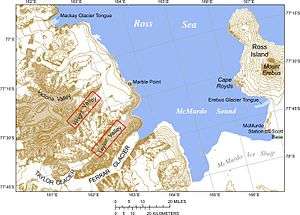
Captain James Clark Ross discovered this sound, which is about 1,300 kilometres (810 mi) from the South Pole, in February 1841, and he named it after Lt. Archibald McMurdo of HMS Terror.[3] The sound today serves as a resupply route for cargo ships and for airplanes that land on the floating ice airstrips near the McMurdo Station. However, McMurdo Station's continuous occupation by human beings since 1957/58 has dirtied the harbor of Winter Quarters Bay.
The pack ice that girdles the shoreline at Winter Quarters Bay and elsewhere in the sound presents a formidable obstacle to surface ships. Vessels require ice-strengthened hulls and often have to rely upon escort by icebreakers. Such extreme sea conditions have limited access by tourists, who otherwise are appearing in increasing numbers in the open waters of the Antarctic Peninsula. The few tourists who reach the McMurdo Sound find spectacular scenery with wildlife to be seen, including killer whales, seals, Adélie penguins, and emperor penguins.
Cold circumpolar currents of the Southern Ocean reduce the flow of warm South Pacific or South Atlantic waters reaching McMurdo Sound and other Antarctic coastal waters. Bitter katabatic winds spilling down from the Antarctic polar plateau into McMurdo Sound demonstrate Antarctica's status as the coldest and windiest continent in the world. The McMurdo Sound freezes over with sea ice about 3 metres (9.8 ft) thick during the winter. The Antarctic summer causes the pack ice to break up. Wind and currents may push the ice northward into the Ross Sea, stirring up cold bottom currents that spill into the ocean basins of the world. Temperatures during the dark winter months at McMurdo Station have dropped as low as −51 °C (−60 °F). However, December and January are the warmest months, with average highs at −1 °C (30 °F) , according to USA Today.
Ice defines strategic role
McMurdo Sound's role as a strategic waterway dates back to early 20th century Antarctic exploration. British explorers Ernest Shackleton and Robert Scott built bases on the sound's shoreline as jumping-off points for their overland expeditions to the South Pole.
McMurdo Sound's logistic importance continues today. Aircraft transporting cargo and passengers land upon frozen runways at Williams Field on the McMurdo Ice Shelf. Moreover, the annual sealift of a cargo ship and fuel tanker rely upon the sound as a supply route to the continent's largest base, the United States' McMurdo Station. Both the U.S. base and New Zealand's nearby Scott Base are on the southern tip of Ross Island.
Ross Island is the southmost piece of land in Antarctica that is accessible by ship. In addition, the harbor at McMurdo's Winter Quarters Bay is the world's southmost seaport (Department of Geography, Texas A&M University). The access by ships depends upon favorable ice conditions.
McMurdo Sound during austral winter presents a virtually impenetrable expanse of surface ice. Even during summer, ships approaching McMurdo Sound are often blocked by various concentrations of first-year ice, fast ice (connected to the shoreline), and hard multi-year ice. Subsequently, icebreakers are required for maritime resupply missions to McMurdo Station. Nonetheless, ocean currents and fierce Antarctic winds can drive pack ice north into the Ross Sea, temporarily producing areas of open water.
Iceberg B-15A clogs McMurdo Sound
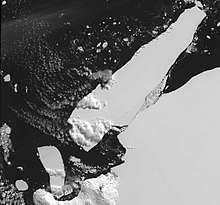
A common event of previously unseen dimensions occurred on the Ross Ice Shelf in 2000 that wreaked havoc at McMurdo Sound more than five years later. The 282-kilometre (175 mi) long Iceberg B-15, the largest ever seen at the time, broke off from the Ross Ice Shelf in March 2000 (Antarctic Climate & Ecosystems: Cooperative Research Center). Then, on 27 October 2005, B-15 suddenly broke up.
Research based upon measurements retrieved from a seismometer previously placed on B-15 indicated that ocean swells caused by an earthquake 13,000 kilometres (8,100 mi) away in the Gulf of Alaska caused the breakup, according to a report by the U.S. National Public Radio.[4] Wind and sea currents shifted a smaller, but still massive Iceberg B-15A towards McMurdo Sound. B-15A's enormous girth temporarily blocked the outflow of pack ice from McMurdo Sound, according to news reports.
Iceberg B-15A's grounding at the mouth of McMurdo Sound also blocked the path for thousands of penguins to reach their food source in open water. Moreover, pack ice built up behind the iceberg in the Ross Sea creating a nearly 150-kilometre (81 nmi) frozen barrier that blocked two cargo ships en route to supply McMurdo Station, according to the National Science Foundation.
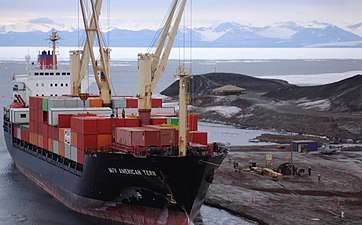
The icebreakers USCGC Polar Star and the Russian Krasin were required to open a ship channel through ice up to 3 metres (9.8 ft) thick. The last leg of the channel followed a route along the eastern shoreline of McMurdo Sound adjacent to Ross Island. The icebreakers escorted the tanker USNS Paul Buck to McMurdo Station's ice pier in late January. The freighter MV American Tern followed on 3 February.
Similar pack ice blocked a National Geographic expedition aboard the 34-metre (112 ft) Braveheart from reaching B-15A. However, expedition divers were able to explore the underwater world of another grounded tabular iceberg. They encountered a surprising environment of fish and other sea life secreted within a deep iceberg crevasse. Discoveries included starfish, crabs, and ice fish. The latter were found to have burrowed thumb-sized holes into the ice.
The expedition reported an exceedingly rare and seldom witnessed occurrence of an iceberg exploding. Shards of ice erupted into the air as if a bomb went off, this only hours after divers surfaced and after the Braveheart moved away from the iceberg (National Geographic).[5]
Effects of wind

Polar winds are a driving force behind weather systems arising from three surface zones that converge at McMurdo Sound: the polar plateau and Transantarctic Mountains, the Ross Ice Shelf, and the Ross Sea. These surface zones create a range of dynamic weather systems. Cold, heavy air descending rapidly from the polar plateau at elevations of 3,000 metres (9,800 ft) or more spawns fierce katabatic winds. These dry winds can reach hurricane force by the time they reach the Antarctic coast. Wind instruments recorded Antarctica's highest wind velocity at the coastal station Dumont d'Urville in July 1972 at 320 kilometres per hour (200 mph) (Australian Government Antarctica Division).
Prevailing winds spilling into McMurdo Sound shoot between mountain passes and other land formations, stirring up blizzards known locally as "Herbies". Such blizzards can occur any time of year. Residents of McMurdo Station and Scott Base have dubbed the nearby White Island and Black Island as Herbie Alley due to winds that funnel blizzards between the islands (Field Manual for the U.S. Antarctic Program).
Overall the continent's extreme cold air scarcely holds enough moisture for snowfall. Consequently, Antarctica's blizzards are at times as much about wind stirring up existing snow as they are about new snowfall. For instance, the water equivalent from annual snow fall on Ross Island averages only 17.6 centimetres (6.9 in) (National Science Foundation). Snowfall in Antarctica's interior is far less at 5 centimetres (2.0 in). Noted as well are the McMurdo Dry Valleys on the western shores of McMurdo Sound where snow seldom accumulates.
Antarctica's shortfall in new snow does not lessen the continent's striking polar climate. Antarctica essentially doubles in size during the winter as the surrounding sea water freezes (Antarctic Connection). The subsequent annual summer melt of the estimated 18,000,000 square kilometres (6,900,000 sq mi) of ice that rings Antarctica creates the planet's largest seasonal climate event (USA Today). The result is a vertical circulation driven by a massive heat and energy exchange between ice, ocean, and atmosphere.
McMurdo Sound provides an important component in Antarctica's global effects upon climate. A key factor is the polar winds that can drive the sound's pack ice into the Ross Sea summer or winter. Frigid katabatic winds rake subsequent exposed water, causing sea ice to form. Freezing surface water excludes salt from the water below; leaving behind heavy, cold water that sinks to the ocean floor. This process repeats itself along Antarctica's coastal areas, spreading cold sea water outward into the world's ocean basins.[6]
According to an interview with a climatologist Gerd Wendler, published in the National Science Foundation's Antarctic Sun, one could dive to the ocean floor anywhere in the world and encounter water from the coast of Antarctica. "Seventy five percent of all the bottom water, wherever you are, comes from Antarctica."
McMurdo Station
- Average mean sea-level temp: −20 °C (−4 °F)
- Monthly mean range: −3 °C (27 °F) in January to −28 °C (−18 °F) in August
- Stormiest months: February and October
Source: U.S. National Science Foundation
Antarctica
- Coldest, highest, windiest continent in the world
- Highest recorded wind velocity: 327 kilometres per hour (203 mph), Dumont d'Urville Station, July 1972
Source: Australian Government Antarctica Division
Life below the ice

A rich sea life thrives under the barren expanse of McMurdo Sound's ice pack. For example, frigid waters that would kill many other fish in the world sustain the Antarctic notothenioids, a bony "ice fish" related to walleyes and perch. The notothenioids feature an Antifreeze protein in their bloodstream that prevents them from freezing. Notothenioids account for more than 50 percent of the number of fish species in the Antarctic coastal regions and 90 to 95 percent of the biomass, according to the National Academy of Sciences for the United States.
What some sea creatures lack in numbers, they make up for in their visual presentation. McMurdo Sound divers encounter colorful examples of sea life, including bright yellow cactus sponges and green globe sponges. Starfish, sea urchins, and sea anemones are also present. The latter is noted for its wispy tentacles. Large sea spiders inhabit the deeps of the sound and feed on sea anemone, whereas swarms of Antarctic krill flourish in the upper depths of the icy waters. The shrimp-like krill is a key species in the Southern Ocean food chain for sea life ranging from the baleen whale to penguins. The sound is also home to soft coral, whose flexible form allows the creature to bend so as to feed off the ocean floor.[7]
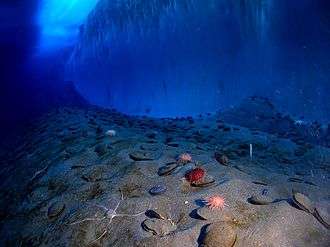
Antarctic penguins, famous for their waddling walk on surface ice, transform themselves into graceful and powerful swimmers underwater. The emperor penguins' pursuit of squid, fish, and crustaceans leads them to dive as deep as 500 metres (1,600 ft). However, the emperor can go deeper. Scientists have found that the penguin can reach 600 metres (2,000 ft) for short durations. The much smaller Adélie penguin is less ambitious. It feeds underwater for up to two minutes at a maximum depth of 170 metres (560 ft).[7]
The Weddell seal out-dives even the emperor penguin. The seal can hold its breath for up to 80 minutes and reach a depth of 700 metres (2,300 ft) (Underwater Field Guide to Ross Island & McMurdo Sound). Scientists diving in McMurdo also encounter the leopard seal, and crabeater seal. The many-storied leopard seal is a ferocious predator that preys on warm-blooded animals, such as other seals and penguins, whereas the more sedate crabeater uses its unusual multilobed teeth to sieve krill from the water.
Seals have a natural enemy in the orca or killer whale of McMurdo Sound. The killer whale's voracious appetite leads it to consume up to 227 kilograms (500 lb) of food daily. The orcas feature black and white coloring, a large dorsal fin up to 1.8 metres (5.9 ft), and enormous strength and size — males can be 8 metres (26 ft). The whales travel in pods of up to 30 individuals and can swim up to 46 kilometres per hour (29 mph).[7]
Seascape reveals human impact
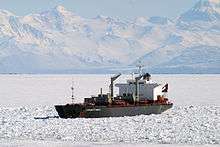
More than 50 years of continuous operation of the United States and New Zealand bases on Ross Island have left pockets of severe pollution marring McMurdo Sound's pristine environment. Until 1981, McMurdo Station residents simply towed their garbage out to the sea ice and let nature take its course. The garbage sank to the sea floor when the ice broke up in the spring, according to news reports.[8]
A 2001 survey of the seabed near McMurdo revealed 15 vehicles, 26 shipping containers, and 603 fuel drums, as well as some 1,000 miscellaneous items dumped on an area of some 20 hectares (49 acres). Findings by scuba divers were reported in the State of the Environment Report, a New Zealand sponsored study.[9][10]
The study by the government agency Antarctica New Zealand revealed that decades of daily pumping thousands of gallons of raw sewage from 1,200 summer residents into the sound had fouled Winter Quarters Bay, the harbor at McMurdo. The pollution ended in 2003 when a $5 million waste treatment plant went online.[11] Other documented bay water contaminants include leakage from an open dump at the station. The dump introduced heavy metals, petroleum compounds, and chemicals into the water.[10]
Zoologist Clive Evans from Auckland University described McMurdo's harbor as "one of the most polluted harbors in the world in terms of oil", according to a 2004 article by the New Zealand Herald.
Modern operations in McMurdo Sound have sparked surface cleanup efforts, recycling, and exporting trash and other contaminants by ship. The U.S. National Science Foundation began a 5-year, $30-million cleanup program in 1989, according to Reuters News Agency.[12] The concentrated effort targeted the open dump at McMurdo. By 2003, the U.S. Antarctic Program reported recycling approximately 70% of its wastes, according to Australia's Herald Sun.
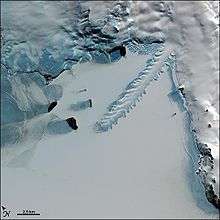
The 1989 cleanup included workers testing hundreds of barrels at the dump site, mostly full of fuels and human waste, for identification before they are loaded onto a freighter for exportation. The precedent for exporting wastes began in 1971. The United States shipped out tons of radiation-contaminated soil after officials shut down a small nuclear power plant.[13]
Yet the very ships involved in supporting the export of McMurdo Station's waste present pollution hazards themselves. A study by the Australian Institute of Marine Science found that anti-fouling paints on the hulls of icebreakers are polluting McMurdo Sound.[14] Such paints kill algae, barnacles, and other marine life that adhere to ship hulls. Scientists found that samples taken from the ocean floor contained high levels of tributyltin (TBT), a component of the anti-fouling paints. "The levels are close to the maximum, you will find anywhere, apart from ship grounding sites", said Andrew Negri of the institute.
Ships, aircraft, and land-based operations in McMurdo Sound all present hazards of oil spills or fuel leaks. For instance, in 2003, the build-up of two years of difficult ice conditions blocked the U.S. tanker MV Richard G. Matthiesen from reaching the harbor at McMurdo Station, despite the assistance of icebreakers. Instead shore workers rigged a temporary 5.6-kilometre (3.5 mi) fuel line over the ice pack to discharge the ship's cargo. The ship pumped more than 23 million litres (6.1 million US gallons) of fuel to storage facilities at McMurdo.[15]
Officials balance the potential for fuel spills inherent in such operations against the critical need to keep McMurdo Station supplied with oil. A fuel tank spill in an unrelated onshore incident in 2003 spilled roughly 25,000 litres (6,600 US gallons) of Diesel fuel at a helicopter pad at McMurdo Station.[16] The 1989 grounding of the Argentinean ship Bahía Paraíso and subsequent spillage of 640,000 litres (170,000 US gallons) of oil into the sea near the Antarctic Peninsula showed the environmental hazards inherent in supply missions to Antarctica.[8]
Tourism surge yet to reach McMurdo
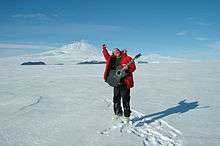
Antarctica's extreme remoteness and hazardous travel conditions limit Antarctica tourism to an expensive niche industry largely centered on the Antarctic Peninsula. The number of seaborne tourists grew fourfold during the 1990s, reaching more than 14,000 by 2000, up from 2,500 ten years earlier.[17] More than 46,000 airborne and seaborne tourists visited Antarctica during the 2007–2008 season, according to the International Association of Antarctic Tour Operators (IAATO).[18]
This confederation of tour operators reports that only 5% of Antarctic tourists visit the Ross Sea area, which encompasses McMurdo Sound. Tourists congregate on the ice-free coastal zones during summer near the Antarctic Peninsula. The peninsula's wildlife, soaring mountains, and dramatic seascapes have drawn commercial visitors since the late 1950s, when Argentina and Chile operated cruises to the South Shetland Islands.[19]
Tourists flights began in 1957, when a Pan American Boeing 377 Stratocruiser made the first civilian flight to Antarctica. Commercial flights landed at McMurdo Sound and the South Pole in the 1960s. Routine overflights from Australia and New Zealand took place between 1977 and 1980, transporting more than 11,000 passengers, according to Antarctica New Zealand, which manages Scott Base. One such flight, Air New Zealand Flight 901, crashed into Mount Erebus on the eastern shores of McMurdo Sound. The crash high on the slopes of the active volcano took the lives of all 257 people aboard the aircraft.
In 1969 the MS Explorer brought seagoing tourists to Antarctica (British Antarctic Survey). The cruise's founder, Lars-Eric Lindblad, coupled expeditionary cruising with education. He is quoted as saying, "You can't protect what you don't know" (IAATO). In the decades since then, ships engaged in Antarctic sight-seeing cruises have grown in size and number.
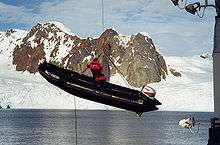
Infrequent Antarctic cruises have included passenger vessels carrying up to 960 tourists (IAATO). Such vessels may conduct so-called "drive-by" cruises, with no landings made ashore.
The Russian Kapitan Khlebnikov has conducted voyages to the Weddell Sea and Ross Sea regions since 1992. High-latitude cruises in dense pack ice are only achievable during the summer season, November into March. In 1997, the vessel Kapitan Khlebnikov claimed the distinction of being the first ship to circumnavigate Antarctica with passengers (Quark Expeditions). Passengers aboard the icebreaker make landings aboard Zodiac inflatable boats to explore remote beaches. Their itinerary may also include stops at Ross Island's historic explorer huts at Discovery Point near McMurdo Station or Cape Royds (Antarctica New Zealand). Additionally, the Russian icebreaker extends the reach of tourism by launching helicopter trips from its decks, including visits to sites such as the McMurdo Dry Valleys and areas noted for wildlife viewing.
The 'Spirit of Enderby has been conducting cruises to the Ross Sea region for many years, including McMurdo Sound. Although the Enderby has an ice-strengthened hull, the ship is not an icebreaker. The Enderby sports Zodiac inflatable boats, a hovercraft for Antarctica voyages, and all-terrain vehicles for over ice or overland travel. Land-based tourism in Antarctica, however, continues to be rare. Antarctica lacks a permanent land-based tourism facility, despite the annual surge in the number of visitors.
The International Association of Tour Operators (IAATO) has established voluntary standards to discourage tourists from disrupting wildlife. Nonetheless, large ships, carrying more than 400 passengers, may spend up to 12 hours transporting tourists to and from breeding sites. Such large-ship operations expose wildlife to humans far longer than smaller vessels.[17]
Prominent features
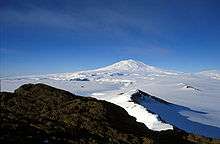
- Beaufort Island – This small island at the northern entrance to McMurdo Sound is a protected area due to its site as a penguin rookery.
- Black Island – This island is west of nearby White Island and is about 25 miles (40 km) from McMurdo Station. An unmanned telecommunications base is here.
- Cape Royds – This is a protected area with the most southerly Adelie penguin colony (Antarctica New Zealand). The site features an expedition hut built by Ernest Shackleton and his crew of the Nimrod in 1907 on western shore of Ross Island.
- Discovery Point – Also called Hut Point, this location overlooking Winter Quarters Bay is the site of the expedition hut built by the British Antarctic Expedition(1901–04) led by Robert Falcon Scott.
- Glacier Ice Tongues – The Erebus Ice Tongue projects 11–12 kilometres (6.8–7.5 mi) from the coastline and reaches up to 10 metres (33 ft) in height. Ice flowing rapidly from the glacier at the base of Mount Erebus forms the ice structure. MacKay Glacier Tongue is across the sound to the northwest at Granite Harbor.
- McMurdo Dry Valleys – This row of valleys on the western shore are so named because of their extremely low humidity and their lack of snow or ice cover.
- McMurdo Ice Shelf – This floating ice shelf forms the southern boundary of McMurdo Sound and is itself part of the larger Ross Ice Shelf.
- Mount Discovery – This isolated volcanic cone on the western shore of McMurdo Sound reaches 2,681 metres (8,796 ft) in height.
- Mount Erebus – This mountain is the southernmost active volcano on Earth. (Antarctic Connection). The mountain reaches 3,794 metres (12,448 ft) in height and is on Ross Island.
- Ross Island – This island features four principal volcanoes: Mount Erebus, Mount Terror, Mount Bird, and Mount Terra Nova. The United States and New Zealand scientific bases are on the southern end of the island.
- Royal Society Range – This volcanic range is part of the Transantarctic Mountains, one of the world's longest mountain chains (Antarctic Connection). The Royal Society Range is on McMurdo Sound's southwestern shore.
- White Island – The McMurdo Ice Shelf encircles White Island, which is visible from Scott Base. A perennial tidal crack in the ice permits Weddell seals to live at the island year round. (Texas A&M University at Galveston LABB)
Gallery
 Orca whale off Ross Island
Orca whale off Ross Island- Orcas in McMurdo Sound
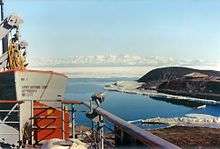 Winter Quarters Bay at McMurdo Station
Winter Quarters Bay at McMurdo Station Iceberg B-15A at McMurdo Sound
Iceberg B-15A at McMurdo Sound.jpg) Icebreakers near McMurdo Station, 29 December 1965
Icebreakers near McMurdo Station, 29 December 1965
See also
Notes
- Christine Elliott (May 2005). "Antarctica, Scott Base and its environs". New Zealand Geographer. 61 (1): 68–76. doi:10.1111/j.1745-7939.2005.00005.x.
- "Maritime Professional - McMurdo Sound". March 14, 2014. Retrieved November 1, 2014.
- "NSF 92-134 Facts about the US Antarctic Program". National Science Foundation. 7 November 1994. Retrieved 23 May 2007.
- Richard Harris (5 October 2006). "Alaskan Storm Plays Role of Butterfly for Antarctica". National Public Radio. Retrieved 23 May 2007.
- Jennifer Goldblatt (1 April 2001). "Aboard the Braveheart: In search of a monster iceberg". St. Petersburg Times (Florida). Retrieved 23 May 2007.
- Australian Government Antarctic Division
- Underwater Field Guide to Ross Island & McMurdo Sound
- "The world's frozen clean room". Business Week. 22 January 1990.
- Tim Radford (17 November 2001). "Thaw puts husky hazards in the path of Scott's successors". The Guardian. Retrieved 23 May 2007.
- Ray Lilley (18 November 2001). "Antarctic sea floor contaminated by human waste near bases". Retrieved 23 May 2007.
- "Reflections from time on the Ice". NBC News. 4 December 2006. Retrieved 23 May 2007.
- "U.S. Antarctic Base at McMUrdo Sound a Dump; Environment: Trashing began in last century with the start of exploration. The waste area is fenced off to slow the escape of wind-blown rubbish", Reuters. December 29, 1991.
- Antarctic dump leaks waste", Courier Mail. 20 March 1991.
- "Toxic chemicals from ice-breaking ships are polluting Antarctic seas", New Scientist. 22 May 2004. This article cites a study by the Australian Institute of Marine Science, which was slated to be published in the Marine Pollution Bulletin.
- "NSF chooses alternative method to refuel its main Antarctic research station; Unusual, multi-year ice conditions keep tanker out of McMurdo Station", M2 Presswire. 27 February 2003
- "Antarctic Research: Station recharged by ship via miles of fuel lines", Science Letter via NewsRx.com and NewsRx.net. 17 March 2003
- "Is rise in tourism helping Antarctica or hurting it?", Travel Watch; National Geographic Traveler. 22 August 2003.
- "IAATO Tourism Statistics". Archived from the original on 2004-07-04.
- Science and Stewardship in the Antarctic: Commission on Geosciences, Environment, and Resources. 1993
References
- A Special Place, Australian Government Antarctic Division.
- Antarctic Connection.
- Antarctica New Zealand Information Sheet.
- Antarctic Climate & Ecosystems: Cooperative Research Center
- The Aster Project.
- British Antarctic Survey.
- Clarke, Peter; On the Ice, Rand McNally & Company 1966.
- Evolution of antifreeze glycoprotein gene from a trypsinogen gene in Antarctic notothenioid fish, Proceedings of the National Academy of Sciences of the United States December 2006.
- Field Manual for the U.S. Antarctic Program.
- First Ever Voyages, Quark Expeditions.
- Fresh Fish, Not Frozen, Origins: Antarctica. Scientific Journeys from McMurdo to the Pole.
- Frozen continent: Time to clean up the ice, New Zealand Herald. January 6, 2004.
- Historical Development of McMurdo Station, Antarctica, an Environmental Perspective, Department of Geography, Texas A&M University; Geochemical and Environmental Research Group, Texas A&M; Uniondale High School, Uniondale New York.
- Ice Bomb Goes Off. National Geographic.
- Icebreakers Clear Channel into McMurdo Station. February 3, 2005.
- International Association of Antarctica Tour Operations (IAAT0).
- Laboratory for Applied Biotelemetry & Biotechnology.
- Management Plan for Antarctic Specially Protected Area (ASPA) No. 121. Antarctica New Zealand.
- MCMURDO DRY VALLEYS REGION, TRANSANTARCTIC MOUNTAINS, National Science Foundation
- McMurdo Station Weather (USA Today).
- NASA's Earth Observatory.
- NewsRx.com
- National Public Radio
- Paint polluting Antarctic, Herald Sun; Melbourne, Australia. May 21, 2004.
- Runaway Iceberg, Reed Business Information, UK; April 16, 2005.
- U.S., Russian icebreakers open path to Antarctic base. USA Today; February 6, 2005.
- The Guardian
- U.S. Antarctic Base at McMurdo Sound a Dump, Reuters News Agency. December 29, 1991.
- Understanding polar weather, USA Today. May 20, 2005.
- Underwater Field Guide to Ross Island & McMurdo Sound.
- U.S. Antarctic Program.
- Where the Wind Blows, Anatarctic Sun. January 28, 2001.
- Why is Antarctica so cold?, Antarctic Connection.
.svg.png)